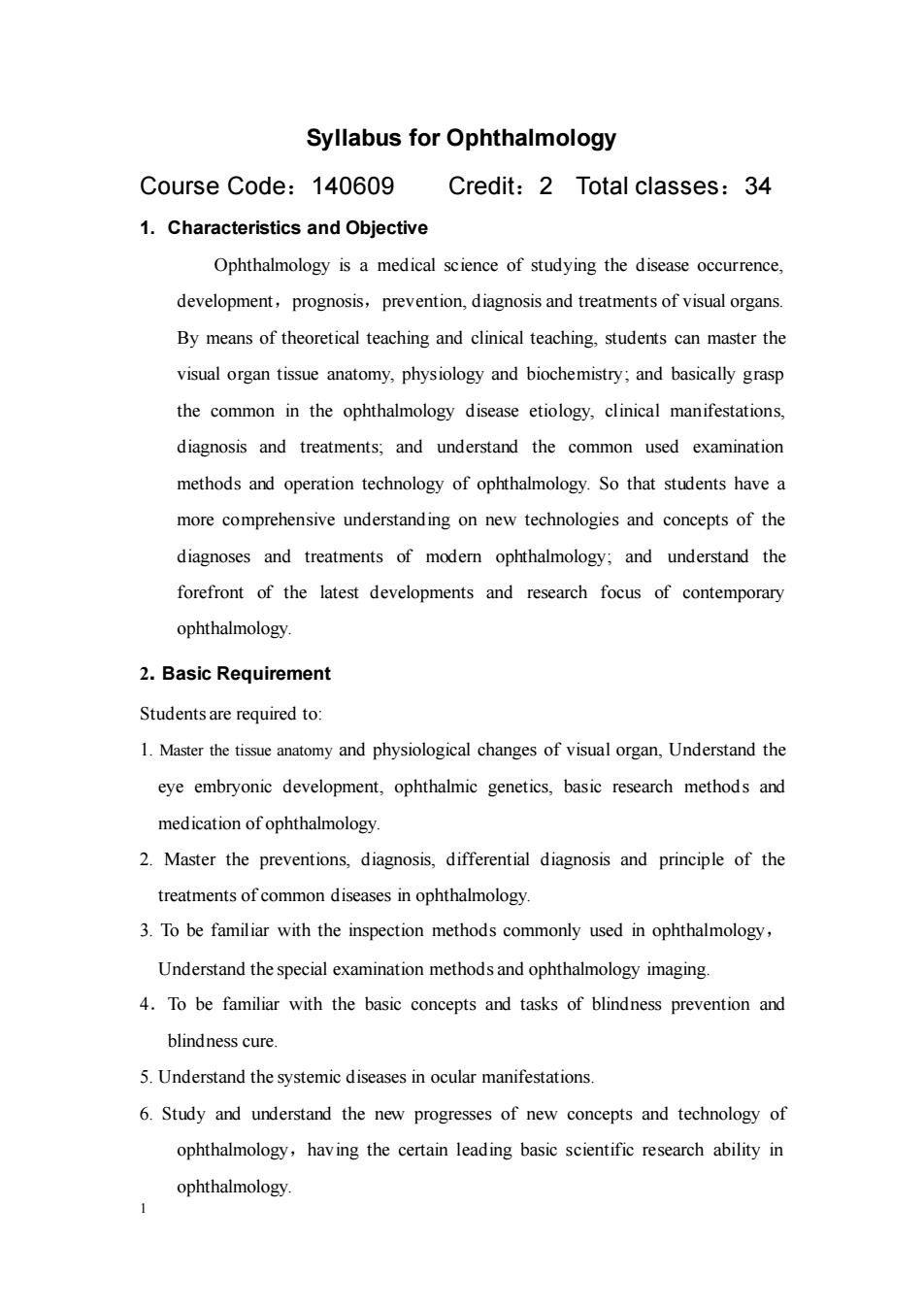
Syllabus for Ophthalmology Course Code:140609 Credit:2 Total classes:34 1.Characteristics and Objective Ophthalmology is a medical science of studying the disease occurrence, development,prognosis,prevention,diagnosis and treatments of visual organs. By means of theoretical teaching and clinical teaching,students can master the visual organ tissue anatomy,physiology and biochemistry:and basically grasp the common in the ophthalmology disease etiology,clinical manifestations, diagnosis and treatments;and understand the common used examination methods and operation technology of ophthalmology.So that students have a more comprehensive understanding on new technologies and concepts of the diagnoses and treatments of modern ophthalmology;and understand the forefront of the latest developments and research focus of contemporary ophthalmology. 2.Basic Requirement Students are required to: 1.Master the tissue anatomy and physiological changes of visual organ,Understand the eye embryonic development,ophthalmic genetics,basic research methods and medication of ophthalmology. 2.Master the preventions,diagnosis,differential diagnosis and principle of the treatments of common diseases in ophthalmology. 3.To be familiar with the inspection methods commonly used in ophthalmology, Understand the special examination methods and ophthalmology imaging. 4.To be familiar with the basic concepts and tasks of blindness prevention and blindness cure. 5.Understand the systemic diseases in ocular manifestations. 6.Study and understand the new progresses of new concepts and technology of ophthalmology,having the certain leading basic scientific research ability in ophthalmology. 1
1 Syllabus for Ophthalmology Course Code:140609 Credit:2 Total classes:34 1. Characteristics and Objective Ophthalmology is a medical science of studying the disease occurrence, development,prognosis,prevention, diagnosis and treatments of visual organs. By means of theoretical teaching and clinical teaching, students can master the visual organ tissue anatomy, physiology and biochemistry; and basically grasp the common in the ophthalmology disease etiology, clinical manifestations, diagnosis and treatments; and understand the common used examination methods and operation technology of ophthalmology. So that students have a more comprehensive understanding on new technologies and concepts of the diagnoses and treatments of modern ophthalmology; and understand the forefront of the latest developments and research focus of contemporary ophthalmology. 2. Basic Requirement Students are required to: 1. Master the tissue anatomy and physiological changes of visual organ, Understand the eye embryonic development, ophthalmic genetics, basic research methods and medication of ophthalmology. 2. Master the preventions, diagnosis, differential diagnosis and principle of the treatments of common diseases in ophthalmology. 3. To be familiar with the inspection methods commonly used in ophthalmology, Understand the special examination methods and ophthalmology imaging. 4.To be familiar with the basic concepts and tasks of blindness prevention and blindness cure. 5. Understand the systemic diseases in ocular manifestations. 6. Study and understand the new progresses of new concepts and technology of ophthalmology,having the certain leading basic scientific research ability in ophthalmology
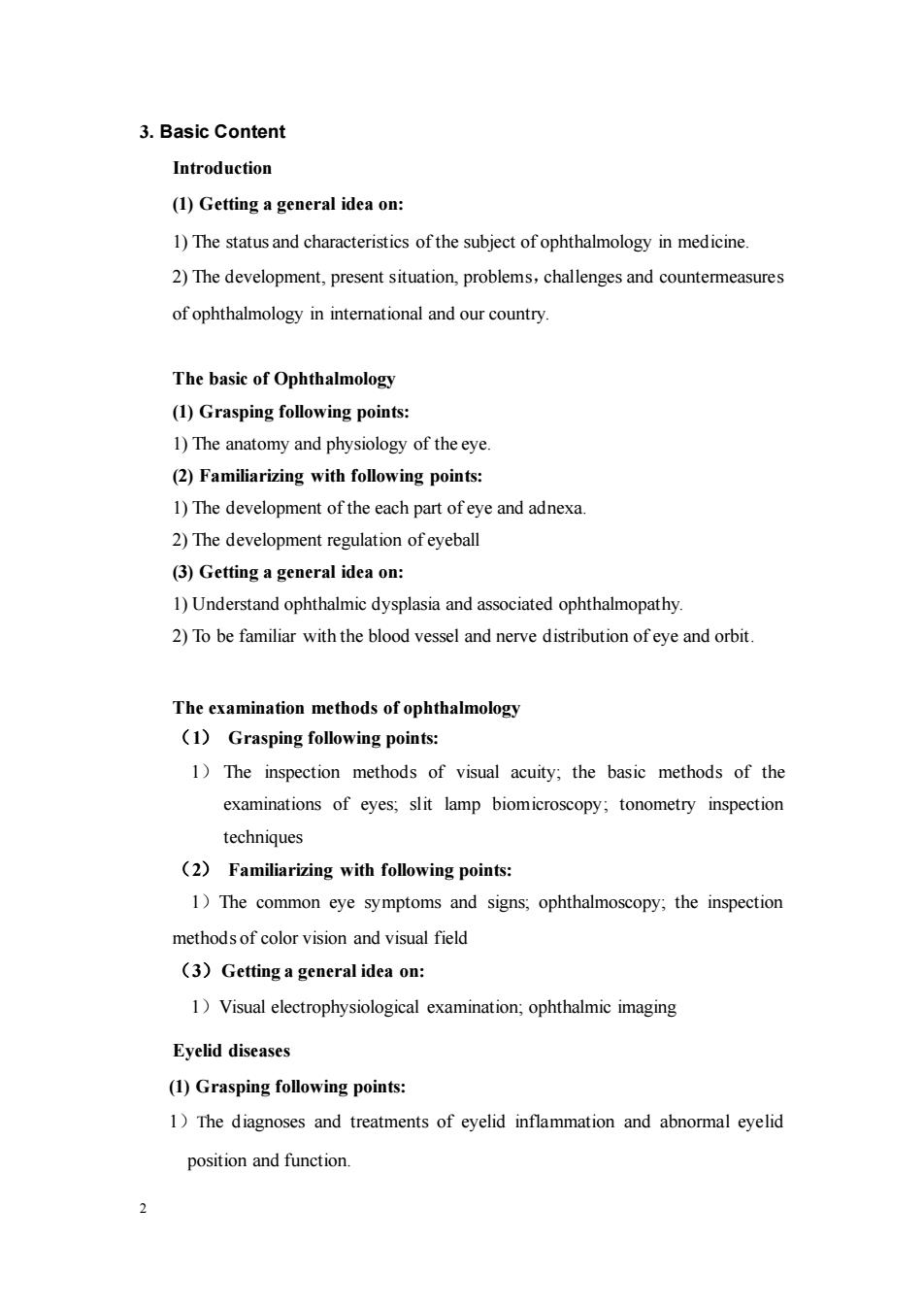
3.Basic Content Introduction (1)Getting a general idea on: 1)The status and characteristics of the subject ofophthalmology in medicine. 2)The development,present situation,problems,challenges and countermeasures of ophthalmology in interational and our country. The basic of Ophthalmology (1)Grasping following points: 1)The anatomy and physiology of the eye. (2)Familiarizing with following points: 1)The development of the each part ofeye and adnexa. 2)The development regulation ofeyeball (3)Getting a general idea on: 1)Understand ophthalmic dysplasia and associated ophthalmopathy 2)To be familiar with the blood vessel and nerve distribution of eye and orbit The examination methods of ophthalmology (1)Grasping following points: 1)The inspection methods of visual acuity;the basic methods of the examinations of eyes;slit lamp biomicroscopy:tonometry inspection techniques (2)Familiarizing with following points: 1)The common eye symptoms and signs,ophthalmoscopy;the inspection methodsof color vision and visual field (3)Getting a general idea on: 1)Visual electrophysiological examination;ophthalmic imaging Eyelid diseases (1)Grasping following points: 1)The diagnoses and treatments of eyelid inflammation and abnormal eyelid position and function 2
2 3. Basic Content Introduction (1) Getting a general idea on: 1) The status and characteristics of the subject of ophthalmology in medicine. 2) The development, present situation, problems,challenges and countermeasures of ophthalmology in international and our country. The basic of Ophthalmology (1) Grasping following points: 1) The anatomy and physiology of the eye. (2) Familiarizing with following points: 1) The development of the each part of eye and adnexa. 2) The development regulation of eyeball (3) Getting a general idea on: 1) Understand ophthalmic dysplasia and associated ophthalmopathy. 2) To be familiar with the blood vessel and nerve distribution of eye and orbit. The examination methods of ophthalmology (1) Grasping following points: 1) The inspection methods of visual acuity; the basic methods of the examinations of eyes; slit lamp biomicroscopy; tonometry inspection techniques (2) Familiarizing with following points: 1)The common eye symptoms and signs; ophthalmoscopy; the inspection methods of color vision and visual field (3)Getting a general idea on: 1)Visual electrophysiological examination; ophthalmic imaging Eyelid diseases (1) Grasping following points: 1)The diagnoses and treatments of eyelid inflammation and abnormal eyelid position and function
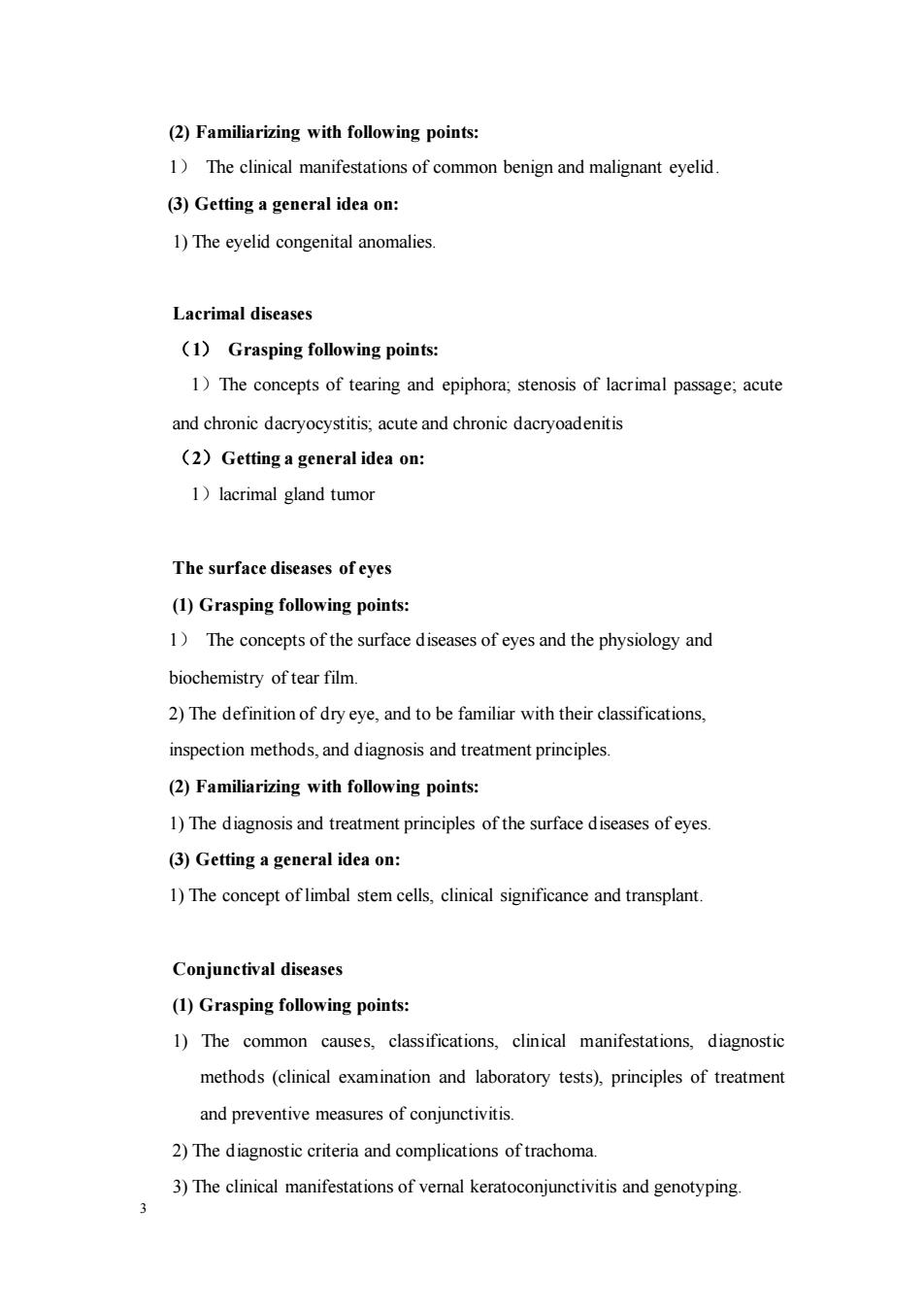
(2)Familiarizing with following points: 1)The clinical manifestations of common benign and malignant eyelid. (3)Getting a general idea on: 1)The eyelid congenital anomalies. Lacrimal diseases (1)Grasping following points: 1)The concepts of tearing and epiphora,stenosis of lacrimal passage;acute and chronic dacryocystitis;acute and chronic dacryoadenitis (2)Getting a general idea on: 1)lacrimal gland tumor The surface diseases of eyes (1)Grasping following points: 1)The concepts of the surface diseases of eyes and the physiology and biochemistry of tear film. 2)The definition of dry eye,and to be familiar with their classifications. inspection methods,and diagnosis and treatment principles (2)Familiarizing with following points: 1)The diagnosis and treatment principles of the surface diseases of eyes. (3)Getting a general idea on 1)The concept of limbal stem cells,clinical significance and transplant Conjunctival diseases (1)Grasping following points: 1)The common causes,classifications,clinical manifestations,diagnostic methods (clinical examination and laboratory tests),principles of treatment and preventive measures of conjunctivitis 2)The diagnostic criteria and complications oftrachoma 3)The clinical manifestations of vemal keratoconjunctivitis and genotyping. 3
3 (2) Familiarizing with following points: 1) The clinical manifestations of common benign and malignant eyelid. (3) Getting a general idea on: 1) The eyelid congenital anomalies. Lacrimal diseases (1) Grasping following points: 1)The concepts of tearing and epiphora; stenosis of lacrimal passage; acute and chronic dacryocystitis; acute and chronic dacryoadenitis (2)Getting a general idea on: 1)lacrimal gland tumor The surface diseases of eyes (1) Grasping following points: 1) The concepts of the surface diseases of eyes and the physiology and biochemistry of tear film. 2) The definition of dry eye, and to be familiar with their classifications, inspection methods, and diagnosis and treatment principles. (2) Familiarizing with following points: 1) The diagnosis and treatment principles of the surface diseases of eyes. (3) Getting a general idea on: 1) The concept of limbal stem cells, clinical significance and transplant. Conjunctival diseases (1) Grasping following points: 1) The common causes, classifications, clinical manifestations, diagnostic methods (clinical examination and laboratory tests), principles of treatment and preventive measures of conjunctivitis. 2) The diagnostic criteria and complications of trachoma. 3) The clinical manifestations of vernal keratoconjunctivitis and genotyping
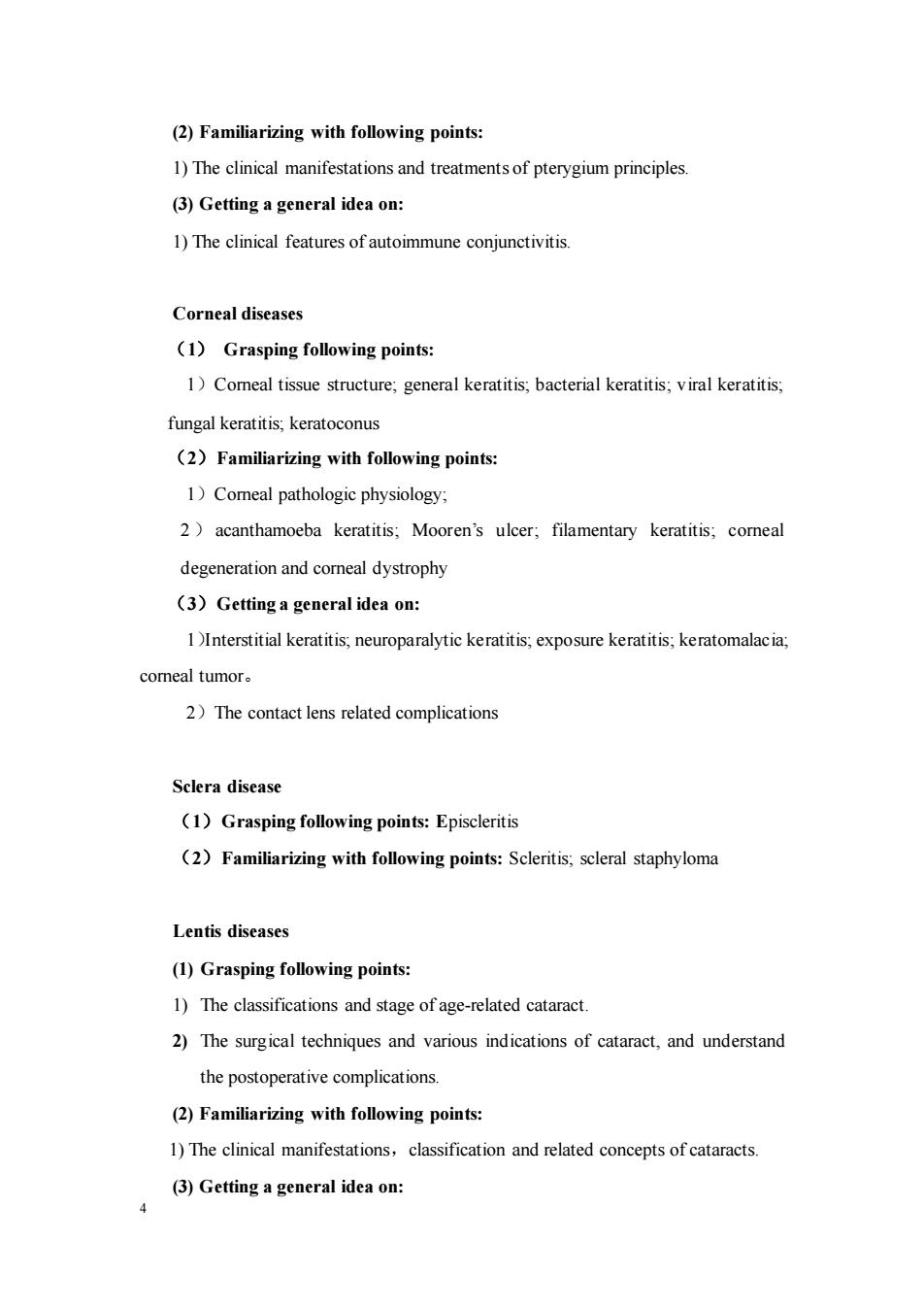
(2)Familiarizing with following points: 1)The clinical manifestations and treatments of pterygium principles (3)Getting a general idea on: 1)The clinical features of autoimmune conjunctivitis. Corneal diseases (1)Grasping following points 1Comeal tissue structure;general keratitis,bacterial keratitis;viral keratitis, fungal keratitis:keratoconus (2)Familiarizing with following points: 1)Comeal pathologic physiology: 2)acanthamoeba keratitis;Mooren's ulcer;filamentary keratitis;comeal degeneration and corneal dystrophy (3)Getting a general idea on: 1Interstitial keratitis,neuroparalytic keratitis;exposure keratitis;keratomalacia; comeal tumor。. 2)The contact lens related complications Sclera disease (1)Grasping following points:Episcleritis (2)Familiarizing with following points:Scleritis,scleral staphyloma Lentis diseases (1)Grasping following points: 1)The classifications and stage ofage-related cataract 2)The surgical techniques and various indications of cataract,and understand the postoperative complications. (2)Familiarizing with following points: 1)The clinical manifestations,classification and related concepts of cataracts (3)Getting a general idea on: 4
4 (2) Familiarizing with following points: 1) The clinical manifestations and treatments of pterygium principles. (3) Getting a general idea on: 1) The clinical features of autoimmune conjunctivitis. Corneal diseases (1) Grasping following points: 1)Corneal tissue structure; general keratitis; bacterial keratitis; viral keratitis; fungal keratitis; keratoconus (2)Familiarizing with following points: 1)Corneal pathologic physiology; 2 ) acanthamoeba keratitis; Mooren’s ulcer; filamentary keratitis; corneal degeneration and corneal dystrophy (3)Getting a general idea on: 1)Interstitial keratitis; neuroparalytic keratitis; exposure keratitis; keratomalacia; corneal tumor。 2)The contact lens related complications Sclera disease (1)Grasping following points: Episcleritis (2)Familiarizing with following points: Scleritis; scleral staphyloma Lentis diseases (1) Grasping following points: 1) The classifications and stage of age-related cataract. 2) The surgical techniques and various indications of cataract, and understand the postoperative complications. (2) Familiarizing with following points: 1) The clinical manifestations,classification and related concepts of cataracts. (3) Getting a general idea on:
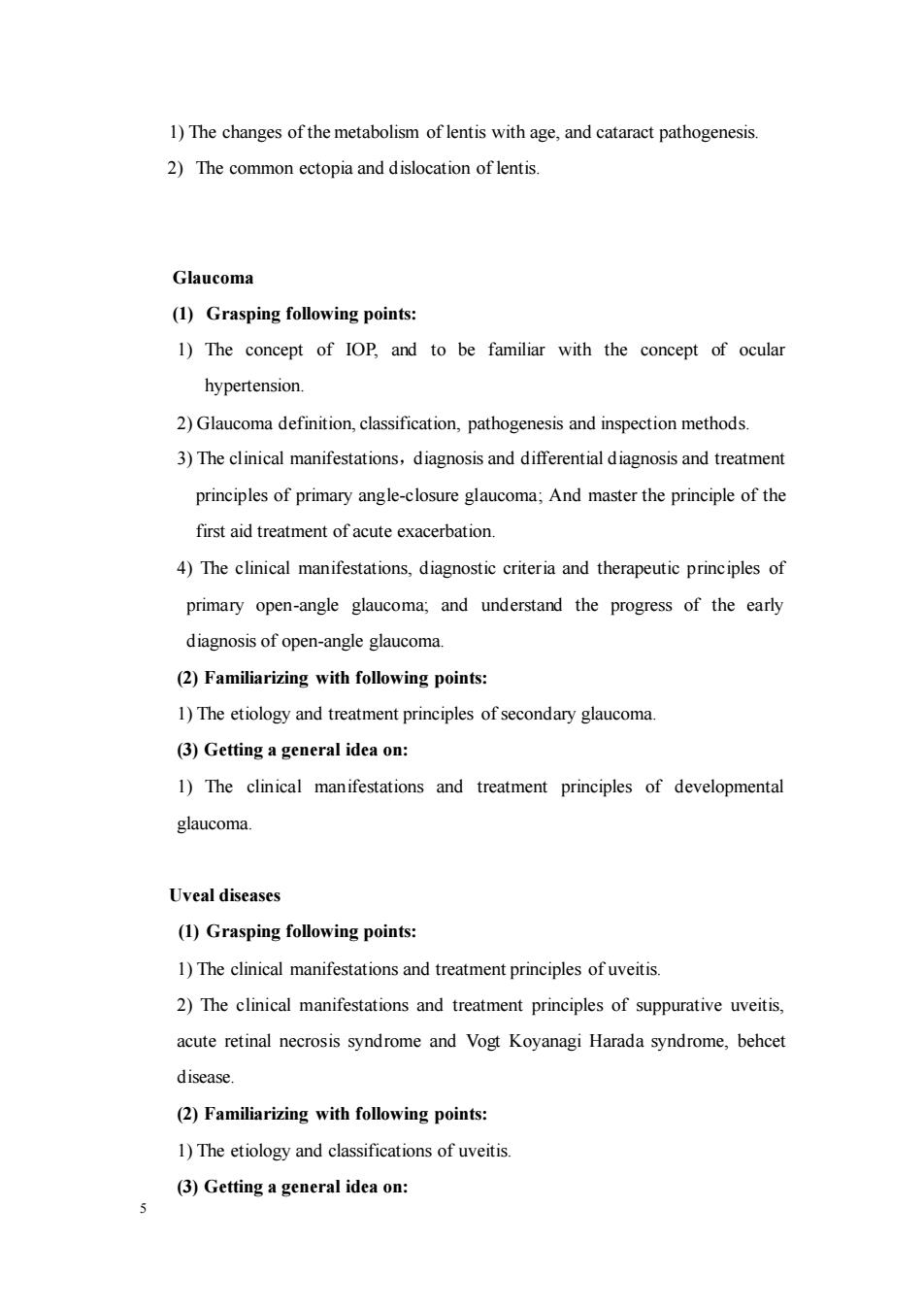
1)The changes of the metabolism of lentis with age,and cataract pathogenesis. 2)The common ectopia and dislocation of lentis. Glaucoma (1)Grasping following points: 1)The concept of IOP and to be familiar with the concept of ocular hypertension. 2)Glaucoma definition,classification,pathogenesis and inspection methods. 3)The clinica manifestations,diagnosis and differential diagnosis and treatment principles of primary angle-closure glaucoma;And master the principle of the first aid treatment of acute exacerbation. 4)The clinical manifestations,diagnostic criteria and therapeutic principles of primary open-angle glaucoma;and understand the progress of the early diagnosis of open-angle glaucoma. (2)Familiarizing with following points: 1)The etiology and treatment principles of secondary glaucoma. (3)Getting a general idea on: 1)The clinical manifestations and treatment principles of developmental glaucoma. Uveal diseases (1)Grasping following points: 1)The clinical manifestations and treatment principles ofuveitis. 2)The clinical manifestations and treatment principles of suppurative uveitis. acute retinal necrosis syndrome and Vogt Koyanagi Harada syndrome,behcet disease. (2)Familiarizing with following points: 1)The etiology and classifications of uveitis (3)Getting a general idea on: 5
5 1) The changes of the metabolism of lentis with age, and cataract pathogenesis. 2) The common ectopia and dislocation of lentis. Glaucoma (1) Grasping following points: 1) The concept of IOP, and to be familiar with the concept of ocular hypertension. 2) Glaucoma definition, classification, pathogenesis and inspection methods. 3) The clinical manifestations,diagnosis and differential diagnosis and treatment principles of primary angle-closure glaucoma; And master the principle of the first aid treatment of acute exacerbation. 4) The clinical manifestations, diagnostic criteria and therapeutic principles of primary open-angle glaucoma; and understand the progress of the early diagnosis of open-angle glaucoma. (2) Familiarizing with following points: 1) The etiology and treatment principles of secondary glaucoma. (3) Getting a general idea on: 1) The clinical manifestations and treatment principles of developmental glaucoma. Uveal diseases (1) Grasping following points: 1) The clinical manifestations and treatment principles of uveitis. 2) The clinical manifestations and treatment principles of suppurative uveitis, acute retinal necrosis syndrome and Vogt Koyanagi Harada syndrome, behcet disease. (2) Familiarizing with following points: 1) The etiology and classifications of uveitis. (3) Getting a general idea on:
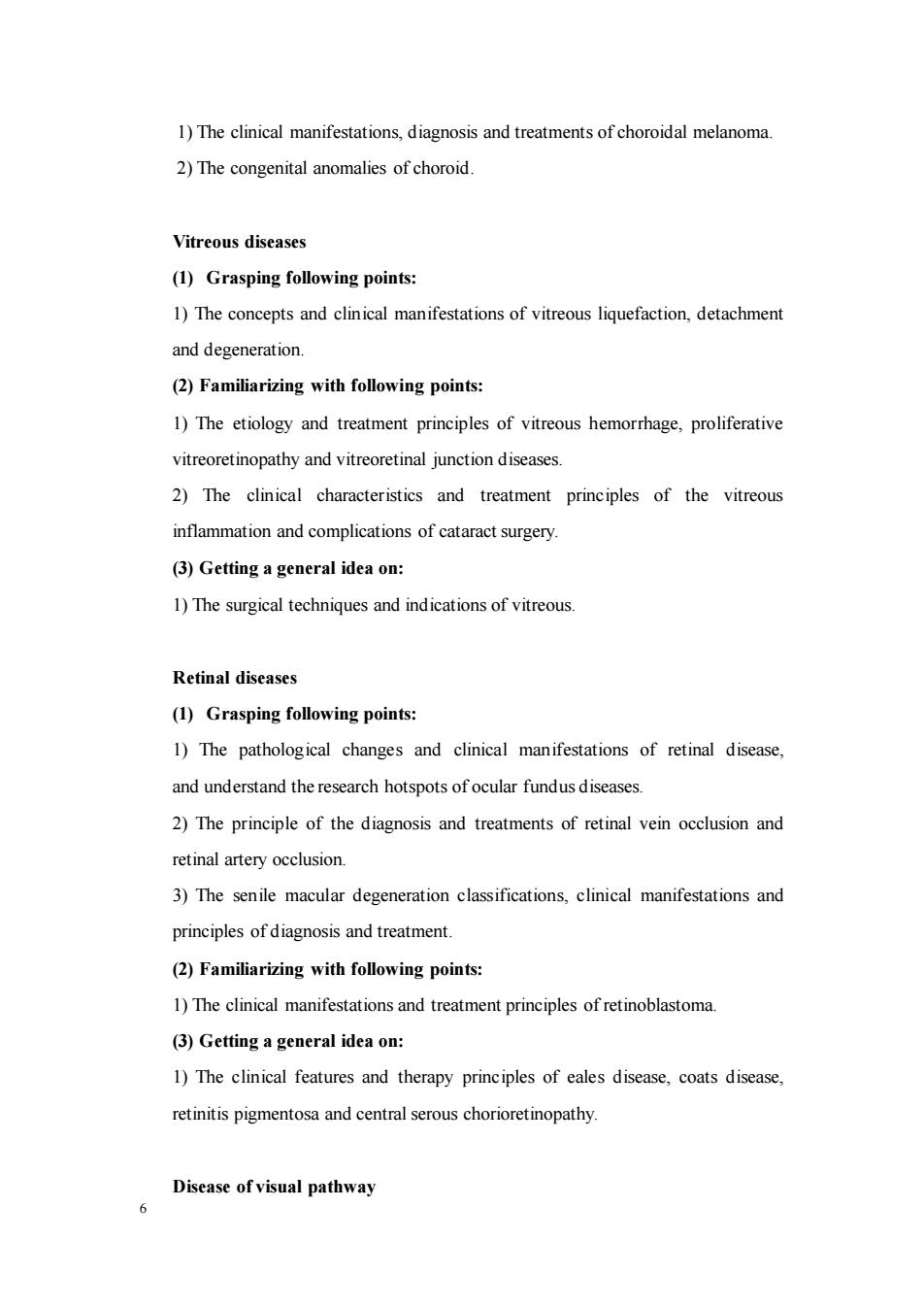
1)The clinical manifestations,diagnosis and treatments of choroidal melanoma. 2)The congenital anomalies of choroid. Vitreousdiseases (1)Grasping following points: 1)The concepts and clinical manifestations of vitreous liquefaction,detachment and degeneration. (2)Familiarizing with following points: 1)The etiology and treatment principles of vitreous hemorrhage,proliferative vitreoretinopathy and vitreoretinal junction diseases 2)The clinical characteristics and treatment principles of the vitreous inflammation and complications of cataract surgery. (3)Getting a general idea on: 1)The surgical techniques and indications of vitreous Retinal diseases (1)Grasping following points: 1)The pathological changes and clinical manifestations of retinal disease. and understand the research hotspots of ocular fundus diseases. 2)The principle of the diagnosis and treatments of retinal vein occlusion and retinal artery occlusion. 3)The senile macular degeneration classifications,clinical manifestations and principles ofdiagnosis and treatment. (2)Familiarizing with following points 1)The clinical manifestations and treatment principles of retinoblastoma (3)Getting a general idea on: 1)The clinical features and therapy principles of eales disease.coats disease. retinitis pigmentosa and central serous chorioretinopathy Disease of visual pathway 6
6 1) The clinical manifestations, diagnosis and treatments of choroidal melanoma. 2) The congenital anomalies of choroid. Vitreous diseases (1) Grasping following points: 1) The concepts and clinical manifestations of vitreous liquefaction, detachment and degeneration. (2) Familiarizing with following points: 1) The etiology and treatment principles of vitreous hemorrhage, proliferative vitreoretinopathy and vitreoretinal junction diseases. 2) The clinical characteristics and treatment principles of the vitreous inflammation and complications of cataract surgery. (3) Getting a general idea on: 1) The surgical techniques and indications of vitreous. Retinal diseases (1) Grasping following points: 1) The pathological changes and clinical manifestations of retinal disease, and understand the research hotspots of ocular fundus diseases. 2) The principle of the diagnosis and treatments of retinal vein occlusion and retinal artery occlusion. 3) The senile macular degeneration classifications, clinical manifestations and principles of diagnosis and treatment. (2) Familiarizing with following points: 1) The clinical manifestations and treatment principles of retinoblastoma. (3) Getting a general idea on: 1) The clinical features and therapy principles of eales disease, coats disease, retinitis pigmentosa and central serous chorioretinopathy. Disease of visual pathway
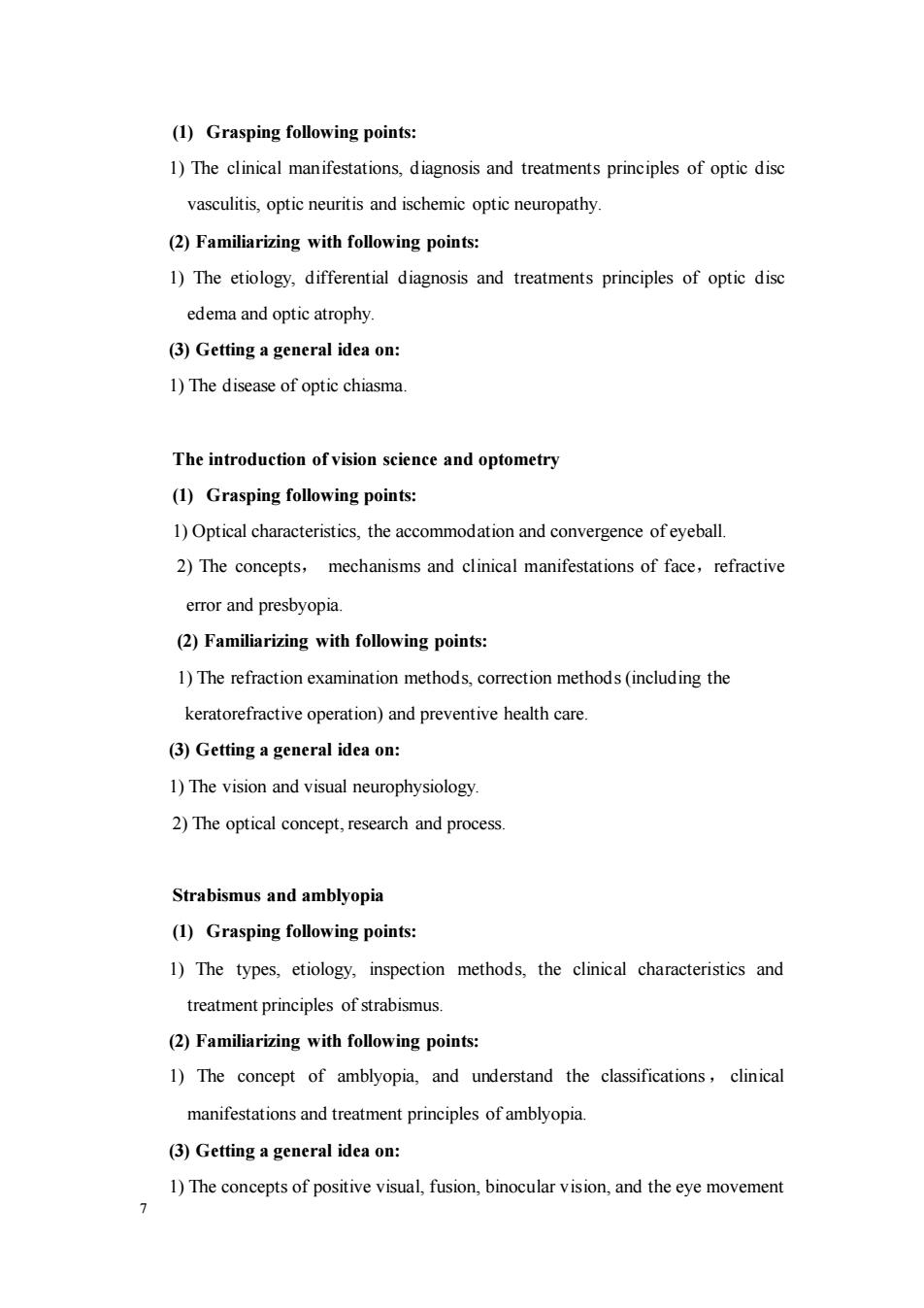
(1)Grasping following points: 1)The clinical manifestations,diagnosis and treatments principles of optic disc vasculitis,optic neuritis and ischemic optic neuropathy (2)Familiarizing with following points: 1)The etiology,differential diagnosis and treatments principles of optic disc edema and optic atrophy. (3)Getting a general idea on 1)The disease of optic chiasma The introduction of vision science and optometry (1)Grasping following points: 1)Optical characteristics,the accommodation and convergence of eyeball. 2)The concepts,mechanisms and clinical manifestations of face,refractive error and presbyopia (2)Familiarizing with following points: 1)The refraction examination methods,correction methods(including the keratorefractive operation)and preventive health care. (3)Getting a general idea on: 1)The vision and visual neurophysiology. 2)The optical concept,research and process. Strabismus and amblyopia (1)Grasping following points: 1)The types.etiology,inspection methods.the clinical characteristics and treatment principles of strabismus. (2)Familiarizing with following points: 1)The concept of amblyopia,and understand the classifications,clinical manifestations and treatment principles of amblyopia (3)Getting a general idea on: 1)The concepts of positive visual,fusion,binocular vision,and the eye movement 7
7 (1) Grasping following points: 1) The clinical manifestations, diagnosis and treatments principles of optic disc vasculitis, optic neuritis and ischemic optic neuropathy. (2) Familiarizing with following points: 1) The etiology, differential diagnosis and treatments principles of optic disc edema and optic atrophy. (3) Getting a general idea on: 1) The disease of optic chiasma. The introduction of vision science and optometry (1) Grasping following points: 1) Optical characteristics, the accommodation and convergence of eyeball. 2) The concepts, mechanisms and clinical manifestations of face,refractive error and presbyopia. (2) Familiarizing with following points: 1) The refraction examination methods, correction methods (including the keratorefractive operation) and preventive health care. (3) Getting a general idea on: 1) The vision and visual neurophysiology. 2) The optical concept, research and process. Strabismus and amblyopia (1) Grasping following points: 1) The types, etiology, inspection methods, the clinical characteristics and treatment principles of strabismus. (2) Familiarizing with following points: 1) The concept of amblyopia, and understand the classifications , clinical manifestations and treatment principles of amblyopia. (3) Getting a general idea on: 1) The concepts of positive visual, fusion, binocular vision, and the eye movement

rule. Orbital diseases (1)Familiarizing with following points: 1)The clinical manifestations and treatment principles of thyroid associated ophthalmopathy. (2)Getting a general idea on: 1)The clinical manifestations and treatment principles of orbital cellulitis and inflammatory pseudotumor. 2)The common clinical manifestations of orbital tumors Ocular trauma (1)Grasping following points: 1)The clinical manifestations,diagnosis and treatment principles of ocular blunt trauma,penetrating injury,and intraocular foreign bodies. (2)Familiarizing with following points: 1)The course,indexing and treatment points of acid-base chemistry (3)Getting a general idea on: 1)The clinical types ofocular trauma. 2)The concept and prevention of sympathetic ophthalmia The ocular manifestations of systemic diseases in common (1)Grasping following points: 1.The pathophysiology,clinical manifestations,diagnosis and treatment principles of eye complications and diabetic retinopathy diabetic changes 2.The stage and the four grade classifications of arteriosclerosis and hypertension retinopathy. (2)Familiarizing with following points: 1)The ocular manifestations and treatment principles of all kinds of common diseases
8 rule. Orbital diseases (1) Familiarizing with following points: 1) The clinical manifestations and treatment principles of thyroid associated ophthalmopathy. (2) Getting a general idea on: 1) The clinical manifestations and treatment principles of orbital cellulitis and inflammatory pseudotumor. 2) The common clinical manifestations of orbital tumors. Ocular trauma (1) Grasping following points: 1) The clinical manifestations, diagnosis and treatment principles of ocular blunt trauma, penetrating injury, and intraocular foreign bodies. (2) Familiarizing with following points: 1) The course, indexing and treatment points of acid-base chemistry. (3) Getting a general idea on: 1) The clinical types of ocular trauma. 2) The concept and prevention of sympathetic ophthalmia. The ocular manifestations of systemic diseases in common (1) Grasping following points: 1. The pathophysiology , clinical manifestations, diagnosis and treatment principles of eye complications and diabetic retinopathy diabetic changes. 2. The stage and the four grade classifications of arteriosclerosis and hypertension retinopathy. (2) Familiarizing with following points: 1) The ocular manifestations and treatment principles of all kinds of common diseases
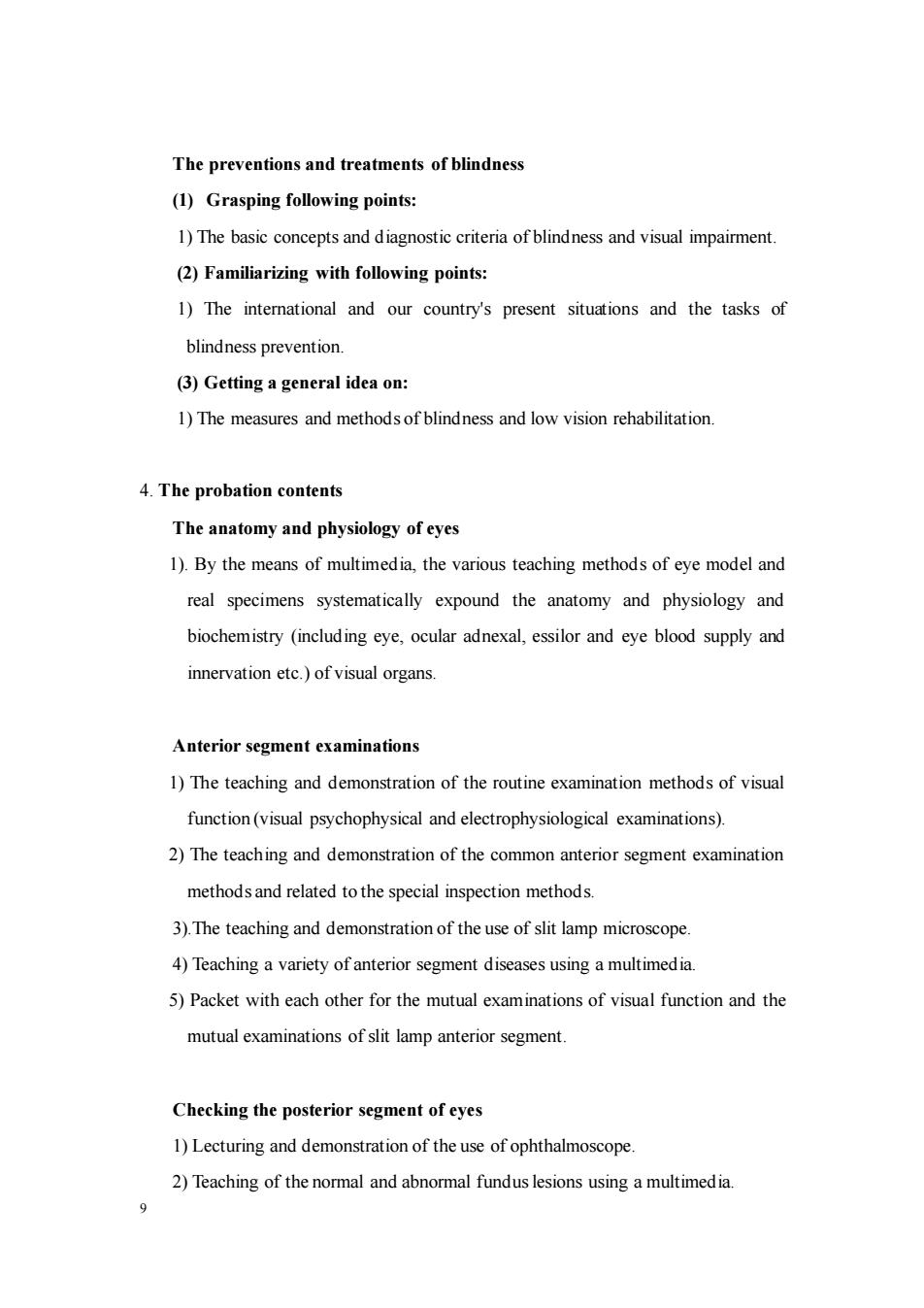
The preventions and treatments of blindness (1)Grasping following points: 1)The basic concepts and diagnostic criteria of blindness and visual impairment. (2)Familiarizing with following points 1)The international and our country's present situations and the tasks of blindness prevention. (3)Getting a general idea on: 1)The measures and methodsof blindness and low vision rehabilitation 4.The probation contents The anatomy and physiology of eyes 1).By the means of multimedia,the various teaching methods of eye model and real specimens systematically expound the anatomy and physiology and biochemistry (including eye,ocular adnexal,essilor and eye blood supply and innervation etc.)of visual organs Anterior segment examinations 1)The teaching and demonstration of the routine examination methods of visual function(visual psychophysical and electrophysiological examinations). 2)The teaching and demonstration of the common anterior segment examination methods and related to the special inspection methods. 3).The teaching and demonstration of the use of slit lamp microscope. 4)Teaching a variety of anterior segment diseases using a multimedia. 5)Packet with each other for the mutual examinations of visual function and the mutual examinations of slit lamp anterior segment. Checking the posterior segment of eyes 1)Lecturing and demonstration of the use of ophthalmoscope. 2)Teaching of the normal and abnormal fundus lesions using a multimedia. 9
9 The preventions and treatments of blindness (1) Grasping following points: 1) The basic concepts and diagnostic criteria of blindness and visual impairment. (2) Familiarizing with following points: 1) The international and our country's present situations and the tasks of blindness prevention. (3) Getting a general idea on: 1) The measures and methods of blindness and low vision rehabilitation. 4. The probation contents The anatomy and physiology of eyes 1). By the means of multimedia, the various teaching methods of eye model and real specimens systematically expound the anatomy and physiology and biochemistry (including eye, ocular adnexal, essilor and eye blood supply and innervation etc.) of visual organs. Anterior segment examinations 1) The teaching and demonstration of the routine examination methods of visual function (visual psychophysical and electrophysiological examinations). 2) The teaching and demonstration of the common anterior segment examination methods and related to the special inspection methods. 3).The teaching and demonstration of the use of slit lamp microscope. 4) Teaching a variety of anterior segment diseases using a multimedia. 5) Packet with each other for the mutual examinations of visual function and the mutual examinations of slit lamp anterior segment. Checking the posterior segment of eyes 1) Lecturing and demonstration of the use of ophthalmoscope. 2) Teaching of the normal and abnormal fundus lesions using a multimedia

3)Teaching and demonstration of the principle,equipment and inspection methods of ophthalmology imaging (such as the A/B-mode ultrasonography fluorescence fundus angiography,retinal optical coherence tomography OCT vision). 4)Lecturing and multimedia teaching of normal and abnormal eye imaging data. 5)Packet with each other for the mutual examination of ophthalmoscope. The clinical probation of ophthalmology 1)Teaching and demonstration of the history collection methods of ophthalmology diseases. 2)Packet with history collections(cataract,glaucoma). 3)Packet with the examinations of slit lamp and patient ophthalmoscopy. 4)Summarize the history and examination results,and the group discussion of diagnosis and therapy. 5)Writing the probation history (homework). 5.Preparatory Course Requirement "anatomy"、"regional anatomy"、"histology and embryology"、"physiology"、 "biochemistry"、"medical microbiology"、"medical immunology"、"pathology"、 "pathophysiology","pharmacology","clinical diagnosis""laboratory diagnosis""medical imaging""epidemiology" 6.Hours Distribution Hours Distribution NO Content Theory Probation Exercise ompute Subtota Hours Hours Hours Hours
10 3) Teaching and demonstration of the principle, equipment and inspection methods of ophthalmology imaging (such as the A/B-mode ultrasonography, fluorescence fundus angiography, retinal optical coherence tomography OCT, vision). 4) Lecturing and multimedia teaching of normal and abnormal eye imaging data. 5) Packet with each other for the mutual examination of ophthalmoscope. The clinical probation of ophthalmology 1) Teaching and demonstration of the history collection methods of ophthalmology diseases. 2) Packet with history collections (cataract, glaucoma). 3) Packet with the examinations of slit lamp and patient ophthalmoscopy. 4) Summarize the history and examination results, and the group discussion of diagnosis and therapy. 5) Writing the probation history (homework). 5. Preparatory Course Requirement "anatomy"、"regional anatomy"、"histology and embryology"、"physiology"、 "biochemistry"、"medical microbiology"、"medical immunology"、"pathology"、 "pathophysiology" 、 "pharmacology" 、 "clinical diagnosis" 、 "laboratory diagnosis"、"medical imaging"、"epidemiology". 6. Hours Distribution NO. Content Hours Distribution Subtotal Theory Hours Probation Hours Exercise Hours Computer Hours